Coombes Surname Ancestry ResultsOur indexes 1000-1999 include entries for the spelling 'coombes'. In the period you have requested, we have the following 388 records (displaying 141 to 150): Single Surname Subscription | | | Buying all 388 results of this search individually would cost £2,218.00. But you can have free access to all 388 records for a year, to view, to save and print, for £100. Save £2,118.00. More... |
These sample scans are from the original record. You will get scans of the full pages or articles where the surname you searched for has been found. Your web browser may prevent the sample windows from opening; in this case please change your browser settings to allow pop-up windows from this site. Insolvents
(1848)
Insolvency notices for England and Wales: insolvency often caused people to restart their lives elsewhere, so these are an important source for lost linksCOOMBES. Cost: £6.00.  | Sample scan, click to enlarge

| Anglican Schoolmasters
(1850)
The Committee of Council on Education awarded certificates of merit to teachers throughout Britain, and published annual lists of those qualifying in the previous years. Masters and mistresses are listed separately, with surname and initials, and school at which teaching, post town or county, and grade of the certificate: each of the three classes of certificate being subdivided into three. There are five separate lists for masters and mistresses:
1. Teachers in schools in connexion with the Church of England; male students in the Training Schools of the National Society, and of the several Diocesan Boards of Education; and female students in the Training Schools of the National Society (Whitelands, Chelsea), the Home and Colonial School Society (Gray's Inn Road, Holborn), and the Salisbury and York and Ripon Diocesan Boards of Education.
2. Teachers, in England and Wales, of British, Wesleyan and other Protestant Schools, not in connexion with the Church of England;
3. Teachers, in England and Wales, of Roman Catholic Schools;
4. Teachers of schools in Scotland, in connexion with the Established Church; male students in the Edinburgh and Glasgow Training Colleges; and female students in training schools.
5. Teachers of schools in Scotland, not in connexion with the Established Church; male students in the Training Schools of the Free Church (at Edinburgh and Glasgow); and female students in training schools.
This is the list, corrected to 1 January 1851, published in 1851.COOMBES. Cost: £4.00.  | Sample scan, click to enlarge
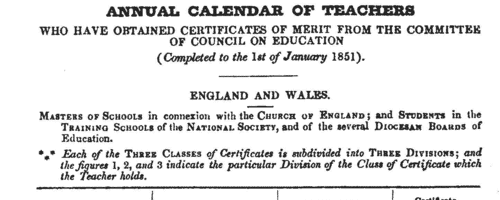
| Inhabitants of Birmingham
(1850)
Francis White & Co.'s History, Gazetteer, and Directory of Warwickshire for 1850 lists nobility, gentry, clergy, other private residents, farmers and traders, hundred by hundred and village by village, with separate sections for the large towns. This long alphabetical section lists inhabitants of Birmingham.COOMBES. Cost: £4.00.  | Sample scan, click to enlarge

| Gentlemen amateur rowers
(1835-1851)
Rowing was one of the English sports covered in detail in the pages of Bell's Life in London, and from these was compiled a compendium called the Aquatic Oracle. The text is divided into two main parts: Gentlemen Amateurs and Watermen. All the entries are cross-referenced, and use these abbreviations: w., won; l., lost; b., beat; bn., beaten; sc. ma., scullers' match; o. ma., oars match; do. sc. ma., double scullers' match; 4 o.ma., 4 oars match; 8 o. ma., 8 oars match; sk., stroke; cox., coxswain; as., a side; Oxon., Oxonian; V. to P., Vauxhall to Putney; W. to P., Westminster to Putney; P. to M., Putney to Mortlake; M. to P., Mortlake to Putney; dis., distance.COOMBES. Cost: £6.00.  | Sample scan, click to enlarge
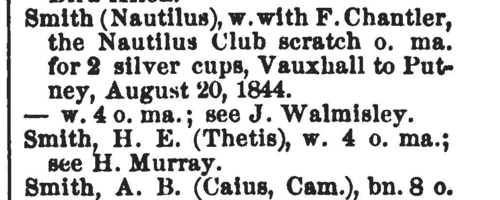
| Watermen rowers
(1835-1851)
Rowing was one of the English sports covered in detail in the pages of Bell's Life in London, and from these was compiled a compendium called the Aquatic Oracle. The text is divided into two main parts: Gentlemen Amateurs and Watermen. All the entries are cross-referenced, and use these abbreviations: w., won; l., lost; b., beat; bn., beaten; sc. ma., scullers' match; o. ma., oars match; do. sc. ma., double scullers' match; 4 o.ma., 4 oars match; 8 o. ma., 8 oars match; sk., stroke; cox., coxswain; as., a side; Oxon., Oxonian; V. to P., Vauxhall to Putney; W. to P., Westminster to Putney; P. to M., Putney to Mortlake; M. to P., Mortlake to Putney; dis., distance.COOMBES. Cost: £6.00.  | Sample scan, click to enlarge
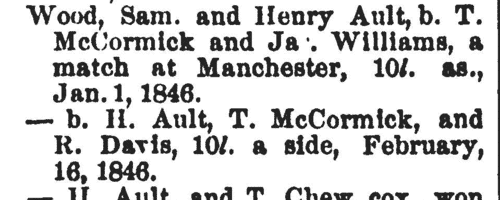
|  Inhabitants of Newington in Surrey
(1851) Inhabitants of Newington in Surrey
(1851)
The 1851 census return for St Mary Newington, Surrey, registration district: St Peter Walworth sub-district: enumeration district 12: described as: "All that Part of the Parish of St. Mary Newington, which Comprises The South Side of Providence St. from the School to Walworth Common, North side of Walworth Common to Burdett St., East side of Burdett St., East side of Ewhurst St. to Clandon St., Clandon St. from Ewhurst St. to Providence St. (both sides), Including Clandon Court, Clifford St. (both sides), Providence Place, Waterloo St. (both sides) and John St. (both sides) to Burdett St." This area lay in the ecclesiastical district of St Peter Walworth, and in the borough of Lambeth. HO 107/1567. The addresses listed in the actual returns are 1 to 4 and 7 to 9
Providence Street (including Lime Cottage); 5 and 6 South Street; 1 to 8 Gloucester Place; 1 to 6 Providence Place; 9 Hour Glass Lane; 1 to 16 Clifford Street; 1 to 19 Burdett Street; 1 to 13 and 19 to 22 and 101 Waterloo Street; The Village Maid beershop; 1 to 8 and 14 and 15 (Saint) John Street; 1 to 11 Ewhurst Street; and 1 to 13, 19 to 30 and 68 to 70 Clandon Street.COOMBES. Cost: £4.00.  | Sample scan, click to enlarge

|  Inhabitants of Newington in Surrey
(1851) Inhabitants of Newington in Surrey
(1851)
The 1851 census return for St Mary Newington, Surrey, registration district: St Peter Walworth sub-district: enumeration district 10: described as: "All that Part of the Parish of St. Mary Newington, which Comprises Surrey Grove, Williams Place, King St. (Both sides), Cross St. (both sides), York Road (both sides), Mina Road (both sides), to Parish boundary & Smyrks Road (both sides)". This area lay in the ecclesiastical district of St Peter Walworth, and in the borough of Lambeth. HO 107/1567. The addresses listed in the actual returns are 1 to 23 Surrey Grove; 1 Surrey Grove Cottages; 1 to 11 Cross Street; 1 to 37 King Street (many house numbers reduplicated); 1 to 11 Mina Road (including Alfred Cottage); 1 to 5 Allen Street; 1 to 20 York Road; 4 to 22 Smyrk's Road; 1 Hen and Chicken Lane; 1 to 7 Williams Place; 3 Cross Street; and 1 Era Court, King Street.COOMBES. Cost: £4.00.  | Sample scan, click to enlarge

|  Inhabitants of Southwark in Surrey
(1851) Inhabitants of Southwark in Surrey
(1851)
The 1851 census return for St George the Martyr, Southwark, registration district: London Road sub-district: enumeration district 16: described as: "Tower Street (both sides) - Short Street - Gloucester Street - Gilbert's Court - Gilberts Passage and Westminster Road No 8 Gilberts Buildings (two doors past the 'Tower') to the corner of the Waterloo Road consisting of Melina Place - Melina Buildings - Elizabeth Place - Oxford Place and the Freemasons' School." This area lay in the parish of St George the Martyr, Southwark. The addresses listed in the actual returns are 8 to 10 Gilbert's Buildings, 2 to 82 Tower Street (including the police station), 2 and 3 Short Street, 2 and 30 Gloucester Street, 2 to 7 Gilberts Court, 42 Gilberts Passage, 4 to 17 Melina Place, 1 to 4 Melina Buildings, 1 to 4 Elizabeth Place, 1 to 3 Oxford Place, Oxford Arms, and Freemasons School.COOMBES. Cost: £4.00.  | Sample scan, click to enlarge

| Pupil Teachers in Sussex: Boys
(1851)
The Committee of Council on Education awarded annual grants for the training and support of pupil teachers and stipendiary monitors in schools in England, Wales, Scotland, the Isle of Man and the Channel Islands. Pupil teachers started training between the ages of 13 and 15, and 'must not be subject to any bodily infirmity likely to impair their usefulness as Pupil Teachers, such as scrofula, fits, asthma, deafness, great imperfections in the sight or voice, the loss of an eye from constitutional disease, or the loss of an arm or leg, or the permanent disability of either arm or leg, curvature of the spine, or a hereditary tendency to insanity'.
They also had to obtain certificates from the managers of the school (and their clergyman, in the case of Church of England schools) as to their moral character and that of their family; good conduct; punctuality, diligence, obedience, and attention to duty; and attentiveness to their religious duties.
This detailed statement in the annual report of the committee for the year ending 31 October 1851 lists schools by county, giving:
1. Name and Denomination of School, with these abbreviations - B, British and Foreign School Society; F. C., Free Church of Scotland; H. C., Home and Colonial School Society; N., National Society, or connected with the Church of England; R. C., Roman Catholic Poor-School Committee; Wesn., Wesleyan Methodist.
2. Annual grants conditionally awarded by the committee in augmentation of teachers' salaries, and in stipends to apprentices, and gratuities to teachers.
3. Month in which annual examination was to be held.
4. Names of apprentices, giving surname and initials, and year of apprenticeship. Stipendiary monitors are indicated by (S. M.).COOMBES. Cost: £6.00.  | Sample scan, click to enlarge
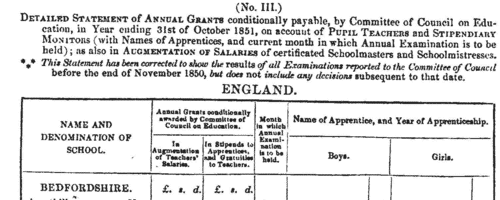
| Pupil Teachers in Wiltshire: Girls
(1851)
The Committee of Council on Education awarded annual grants for the training and support of pupil teachers and stipendiary monitors in schools in England, Wales, Scotland, the Isle of Man and the Channel Islands. Pupil teachers started training between the ages of 13 and 15, and 'must not be subject to any bodily infirmity likely to impair their usefulness as Pupil Teachers, such as scrofula, fits, asthma, deafness, great imperfections in the sight or voice, the loss of an eye from constitutional disease, or the loss of an arm or leg, or the permanent disability of either arm or leg, curvature of the spine, or a hereditary tendency to insanity'.
They also had to obtain certificates from the managers of the school (and their clergyman, in the case of Church of England schools) as to their moral character and that of their family; good conduct; punctuality, diligence, obedience, and attention to duty; and attentiveness to their religious duties.
This detailed statement in the annual report of the committee for the year ending 31 October 1851 lists schools by county, giving:
1. Name and Denomination of School, with these abbreviations - B, British and Foreign School Society; F. C., Free Church of Scotland; H. C., Home and Colonial School Society; N., National Society, or connected with the Church of England; R. C., Roman Catholic Poor-School Committee; Wesn., Wesleyan Methodist.
2. Annual grants conditionally awarded by the committee in augmentation of teachers' salaries, and in stipends to apprentices, and gratuities to teachers.
3. Month in which annual examination was to be held.
4. Names of apprentices, giving surname and initials, and year of apprenticeship. Stipendiary monitors are indicated by (S. M.).COOMBES. Cost: £6.00.  | Sample scan, click to enlarge
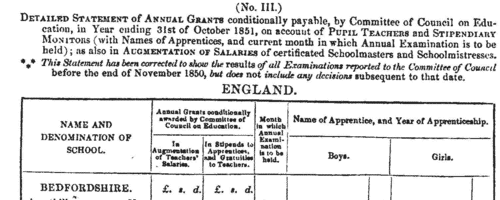
|
Research your ancestry, family history, genealogy and one-name study by direct access to original records and archives indexed by surname.
|













